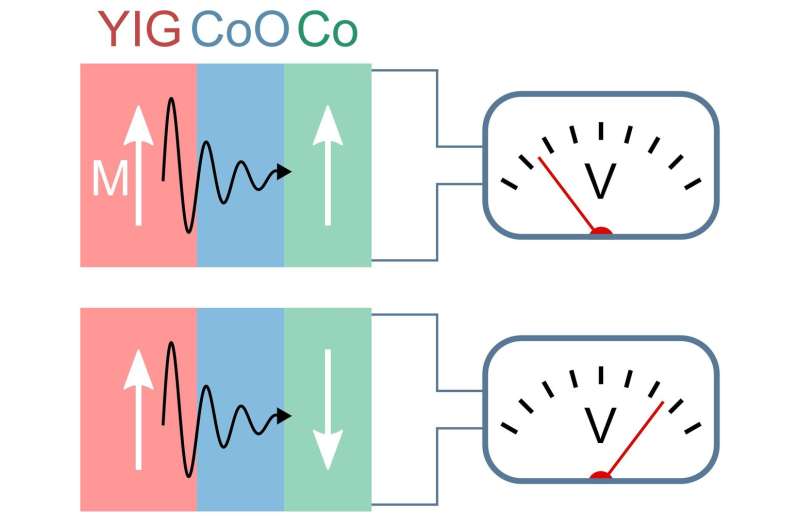Magnon spin currents can be controlled via spin valve structure

In the emerging field of magnon spintronics, researchers seek to transport and process information by means of so-called magnon spin currents. In contrast to electrical currents, on which todays information technology is based, magnon spin currents conduct magnetic momenta. These are mediated by magnetic waves, or magnons, which propagate through magnetic materials. One fundamental building block of magnon spintronics is magnon logic, by which logic operations are processed by the superposition of spin currents.
An international team of physicists from Johannes Gutenberg University Mainz (JGU) and the University of Konstanz in Germany and Tohoku University in Sendai, Japan, recently succeeded in adding a further element to the construction set of magnon logic. In a so-called spin valve structure comprising several ferromagnets, it was possible to demonstrate that the detection efficiency of magnon currents depends on the magnetic configuration of the device. Generally, this allows researchers to control the transmission or blocking of incoming information. The research work has been published in the online journal Nature Communications with a fellow of the JGU-based Graduate School of Excellence Materials Science in Mainz (MAINZ) as first author.
The essential aim of magnon spintronics is to replace electrical charge as the information carrier with magnons. Among other things, magnons offer the possibility of wave-based computing, which provides more options for logical data processing. Magnons furthermore propagate in magnetic insulators with comparably small losses, which holds out the prospect of the implementation of improved energy efficiency of data processing.
The investigated spin valve structure is a trilayer system comprising the insulating ferromagnet yttrium iron garnet (YIG), the insulating antiferromagnet cobalt(II) oxide (CoO), and the metallic ferromagnet cobalt (Co): YIG/CoO/Co. By means of the oscillating magnetic fields of irradiated microwaves, the deliberate rotation of the YIG magnetization is induced, which emits a magnon spin current into the CoO. In the metallic Co layer, the magnon spin current gets converted into a charge current due to the so-called inverse spin Hall effect, and is thus detected.
Switch-like device forwards or suppresses magnon current as electric signal
The experiment demonstrated that the amplitude of the detected signal strongly depends on the magnetic configuration of the spin valve. In the case of antiparallel alignment of the YIG and Co magnetization, the signal amplitude is approximately 120 percent larger than in the parallel state. The repetitive switching of the Co magnetization further revealed the robustness of the effect and likewise its suitability for long-time operation. "Altogether, this effect to some extent allows the implementation of a switch-like device, which suppresses or forwards the magnon current as an electrical signal," said Joel Cramer, first author of the article and member of the Graduate School of Excellence Materials Science in Mainz. "The result of our experiment is an effect which might find application in prospective magnon logic operations, thus yielding an essential contribution to the field of magnon spintronic," Cramer added.
More information: Joel Cramer et al, Magnon detection using a ferroic collinear multilayer spin valve, Nature Communications (2018). DOI: 10.1038/s41467-018-03485-5
Journal information: Nature Communications
Provided by Universitaet Mainz





















